Generational Role Reversals
Convenience-seeking seniors, skilled Millennial scratch cooks, and health-minded kids are among the emerging population groups that are driving demand for new products.

Members of the enormous sector of senior consumers are more active, healthy, and wealthy than ever before. Households continue to shrink in size. Multiculturalism is a defining characteristic of U.S. society. And America’s economic divide—the ever-widening chasm between rich and poor—is a sobering economic reality. These are just a few of the demographic factors that are creating new opportunities and prompting marketers to restructure their priorities.
From kids to aging adults, consumers are switching gears and shopping, cooking, and dining out differently than they did in the past—often in ways that were once associated with older or younger segments of the population. Young adults, for example, are confident in their cooking skills and are preparing meals from scratch almost as frequently as older consumers. Baby Boomers, meanwhile, are popping frozen meals into the microwave in the name of convenience and dining out every chance they get—behaviors once more associated with those in the 18- to 34-year-old age range.
Dramatic and unanticipated changes in food attitudes and behaviors among the seemingly complacent, high-spending Baby Boomer and Mature consumers are creating a bevy of new product demands that will keep this large segment of the population center stage for food marketers. In fact, by 2019, more than half of the U.S. population will be aged 50-plus (IDDBA 2015). In 2014 Boomers and seniors drove more than 50% of all consumer packaged goods spending, accounting for more than $207 billion in sales; they are projected to contribute $230 billion in sales by 2020 (IRI 2014a).
Demographic Directions
America’s 319 million consumers are divided into four adult generations and a newly invented kids’ cohort, dubbed Generation Z (U.S. Census 2010). Although the U.S. Census Bureau has established age brackets for the Mature, Boomer, and Gen X segments, they have not defined the Millennial or Gen Z cohorts. As a result, there is confusion as to when the Millennials, the children of the Boomers, will represent a larger slice of the population pie than their parents’ generation.
If the Millennial generation is defined as those between the ages of 18 and 34, these young consumers will number 75.3 million in 2015 and will begin to surpass the 74.9 million Baby Boomers, aged 51–69. The Gen X population, aged 35–50 in 2015, will outnumber the Boomers by 2028. As a side note, if the traditional definition of Millennials as being born between 1981 and 2000 is taken into account, this group would total 87 million people aged 15–34 (Fry 2015).
Millennials are on-the-go consumers with a strong interest in fresh foods, and they are driving the trend to immediate consumption. In 2013 40% of Millennials’ eating occasions involved foods/beverages consumed within an hour of purchase; 25% of their meals were purchased and eaten the same day (Hartman 2013a).
Unlike generations before them, 60% of Millennials enjoy cooking. One-third of all their eatings involve ethnic foods; 25% of their foodservice eatings are contemporary ethnic, such as Indian and Thai fare (Hartman 2013b).
Millennials are round-the-clock eaters: 12% of eating occasions are at breakfast; 16% are for a morning snack; 15%, lunch; 17%, an afternoon snack; 18%, dinner; and 20%, an evening snack (Hartman 2013b).
Gen X—born between 1965 and 1980—totals 66 million people. Gen X has the highest proportion of working adults and is the most likely to have kids at home. They are considered time-strapped and value-conscious (U.S. Census 2010).
--- PAGE BREAK ---
 The Boomers—born between 1946 and 1964—have the highest disposable income despite the fact that nearly half of this cohort is already retired (U.S. Census 2010).
The Boomers—born between 1946 and 1964—have the highest disposable income despite the fact that nearly half of this cohort is already retired (U.S. Census 2010).
Matures—now aged 70–87—total 29 million. Matures cook at home more frequently than others and eat breakfast most regularly (FMI 2014; Packaged Facts 2014a).
Unlike former generations of older adults, Boomers and Matures are now the most frequent visitors to restaurants (NPD 2013a). Not surprisingly, these older cohorts also have a new penchant for convenience cooking. Matures are now the most likely to use the microwave oven to cook and—along with Millennials—to eat frozen meals (Packaged Facts 2014a).
Older consumers take a balanced approach to healthy eating, planning meals around the basic four food groups. In 2014 older meal preparers served meat/poultry entrees, vegetable side dishes, bread/rolls, green salads, and side dishes more frequently at dinner than their younger counterparts, who served appetizers and vegetarian/meatless entrées more often (MSI 2014a; Figure 1).
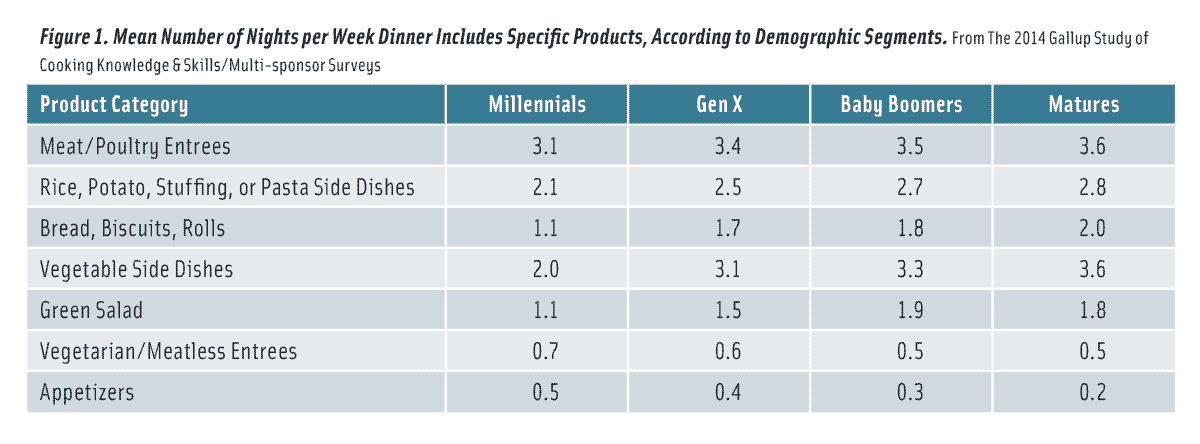 Although still forming their longer-term food attitudes, members of Gen Z, aged 15 and younger, are already characterized as focusing on fresh, easy-to-assemble meals (NPD 2011). NPD Group predicts the largest gains in annual eatings for Gen Z from 2013 to 2018 will be in the categories of salads, quick-assembly lunches/sandwiches, breakfast foods, heat-and-eat entrees, and side dish breads.
Although still forming their longer-term food attitudes, members of Gen Z, aged 15 and younger, are already characterized as focusing on fresh, easy-to-assemble meals (NPD 2011). NPD Group predicts the largest gains in annual eatings for Gen Z from 2013 to 2018 will be in the categories of salads, quick-assembly lunches/sandwiches, breakfast foods, heat-and-eat entrees, and side dish breads.
Sales of kid-specific foods/beverages are projected to jump from $32 billion in 2013 to $41 billion by 2018. In 2013 23% of the best-selling new foods/drinks were kid-specific, up from 16% in 2012 (IRI 2014b). In descending order, dairy, snacks, frozen food, drinks, and cereal remain the largest kid-specific categories (Packaged Facts 2014b).
Total baby food category sales will decline by a compound annual growth rate of 1% to $5.4 billion in 2017. Infant formula sales will drop by a compound annual growth rate of 2.1% to $3.7 billion, while prepared baby food sales will increase by about 1.5% to $1.7 billion (Packaged Facts 2013a). In 2013 there were 3,932,181 births in the United States, down less than 1% from 2012 (HHS 2015).
Ethnic diversity is highest among the youngest generations. Caucasians make up about half of Gen Z, 59% of Millennials, and 74% of Boomers. When it comes to the adult population, in 2014 there were 56 million U.S. Hispanics (17.6% of the population), 40 million African-Americans (12.7%), and 16 million Asians (5%) (U.S. Census 2010).
With two-person, married couple households with no children at home (57 million) and households with persons living alone (31 million) the two largest U.S. household units, foods that can be easily portioned or packaged for one or two adults will gain in popularity (U.S. Census 2010). In fact, empty nesters are driving a new couples’ weekend dinner occasion, which represented 5.3 billion eating occasions in 2014 (Hartman 2015).
While higher-income households (those earning more than $100,000) will continue to grow, albeit more slowly than in the past, savvy marketers are turning their attention to the large and growing cohort of lower-income shoppers. Low-income households (annual incomes of $35,000 or less), which are projected to increase from 45% of U.S. households in 2015 to 51% by 2020, are expected to deliver $118 billion in new incremental consumer packaged goods revenue from 2010 to 2020 (IRI 2010).
Better targeting America’s 22.8 million households supported by the U.S. Dept. of Agriculture’s Supplemental Nutrition Assistance Program (SNAP, formerly food stamps) with foods and beverages that deliver high value is a very big idea (IRI 2015). Last-minute meal solutions, affordable real food options, meat-inclusive meals, and kid- and family-focused products represent opportunities in the marketplace (IRI 2015).
Low-income households are key players in the cold cereal, yogurt, frozen dinner/entrée, frozen pizza, fresh bread/rolls, natural cheese, soup, luncheon meat, salty snack, crackers, cookies, ice cream, and chocolate candy categories (IRI 2010).
--- PAGE BREAK ---
 Generational Approaches to Meal Preparation
Generational Approaches to Meal Preparation
Millennials remain an exciting target for at-home meal preparation since they ate eight more meals at home in 2014 compared with 2013 (NPD 2015a). In 2014 Millennials prepared dinner at home 4.5 nights per week versus members of Gen X, who made five dinners; Baby Boomers, 5.1; and those 65-plus, 5.2 (FMI 2014).
In 2014 52% of Matures made dinner primarily from fresh/raw ingredients, down from 56% in 2011, versus 39% of Millennials who did so, up from 27% in 2011 (MSI 2011a, 2014a). For the first time, the percentage of cooks who made dinner using prepackaged foods that require preparation (20%) or by simply heating and serving prepackaged foods (14%) was consistent across all generations (MSI 2014a). Packaged meal kits, frozen stir-fry dinner kits, refrigerated heat-and-eat-potatoes/pasta, and refrigerated entrees/main meals are among the prepackaged foods more popular with younger meal preparers (MSI 2014a).
Nearly six in 10 Millennials (57%) and 48% of Gen Xers enhance convenience almost all the time by adding ingredients/flavorings (MSI 2014a). Adults aged 45-plus are the most likely to use specialty/gourmet foods for everyday meal preparation; those aged 65-plus are the top purchasers of specialty oils. Those aged 35–44 are the most likely to use specialty foods for cooking shortcuts (SFA 2014).
Millennials and Gen Xers are the most likely to use the oven, stir-fry, sauté, boil, steam, use no cook preparations, and cook ethnic foods from scratch. Boomers are the most likely to grill and/or use a Crock-Pot. Matures are most likely to broil, roast, and sear (Mintel 2013a; MSI 2014a).
Millennial at-home ethnic cooking has increased by 28% over the past five years (FMI 2015). Four in 10 Millennials cook Mexican/Hispanic food from scratch; 18%, Chinese; 13%, Cajun; 12%, Japanese; and 10%, Caribbean (Mintel 2014a).
Millennials and Gen Xers are twice as likely as their older counterparts to bake bread, rolls, or muffins and to make spaghetti and barbecue sauce from scratch (MSI 2014a). Spicy/hot, authentic U.S. regional, international/ethnic (e.g., Indian Masala), sweet, local brand/chef/restaurant, salty, artisanal, sour, and unusual are the preferred sauce/marinade flavors for those aged 18–34 (Mintel 2013b).
Millennials and Gen Xers are almost twice as likely as older consumer to prepare dinner from takeout (MSI 2014a). Along with Hispanics, they’re the most likely to use prepared foods from the deli (IDDBA 2014).
Young Millennials are the most likely to buy refrigerated fresh meals (Technomic 2013a). Those aged 18–24, Matures, and those with incomes of less than $49,000 per year are the most likely to often eat frozen dinners (Packaged Facts 2014a).
Millennials are shopping differently for food, focusing on building a meal or eating occasion versus the more traditional approach of stocking up the pantry with a list of basics for future meals/snacks (FMI 2014). Young cooks are more interested than other generations in easy-to-make dinner recipes (59%), recipes for meals under $10 (60%), and placement of entire dinner solutions in-store (35%) (FMI 2014).
Nearly half of men (46%) are involved in day-to-day meal preparation (MSI 2014a). Forty-three percent of men are the primary household grocery shopper (FMI 2014).
--- PAGE BREAK ---
Flavors and Favorites
Young adults continue to drive sales of the $109 billion specialty food sector; 70% of those aged 18–34 bought gourmet foods in 2014 (SFA 2014 2015).
 Young Millennials were the top purchasers of gourmet chocolate, salty snacks, meat/poultry/seafood, frozen desserts, tea, cookies, pasta, condiments, and frozen entrees; those aged 25–34 were the top purchasers of gourmet yogurt, rice/grains, cakes/pies, gourmet beverages of all kinds, sauces, and ready-to-eat foods (SFA 2014).
Young Millennials were the top purchasers of gourmet chocolate, salty snacks, meat/poultry/seafood, frozen desserts, tea, cookies, pasta, condiments, and frozen entrees; those aged 25–34 were the top purchasers of gourmet yogurt, rice/grains, cakes/pies, gourmet beverages of all kinds, sauces, and ready-to-eat foods (SFA 2014).
Although the obsession with new/unique flavors peaked in 2011, older Millennials are still willing to spend more on foods/beverages with unusual flavors. Those aged 18–34 are the most interested in flavors that are ethnic, coupled (e.g., chili-lime), bold, and/or spicy (Techonomic 2013b).
Millennials are the most likely to eat Southern foods, sushi, and international fare, including Thai, Spanish, Greek, Indian, Japanese, and Middle Eastern (FMI 2014; SFA 2014). Older Boomers are the most likely to purchase regional American foods/foods associated with a particular state. Chinese foods are second only to Italian for those aged 65-plus (SFA 2014).
Men are more likely than women to purchase Mexican, regional American, Hispanic, French, and Middle Eastern foods (SFA 2014). Those aged 18–34 are the most likely to buy tortillas, focaccia/ciabatta, flatbreads, flavored artisan breads (e.g., olive), Middle Eastern breads (e.g., lavash), challah/brioche, and naan breads (Mintel 2014b).
Older Millennials and younger Baby Boomers are the most likely to eat ancient grains, including quinoa, couscous, millet, bulgur, and spelt (Mintel 2013c). Pasta consumption in all forms drops off dramatically after age 55 (Mintel 2014c).
Consumption of fruit, vegetables, and fruit juice increases with age among adults. Fruit juice and fruit consumption decline with age among kids and teens; vegetable consumption increases slightly (PMA 2015).
Nearly three-quarters of those aged 18–34 expect to purchase more smoothies made from scratch at foodservice locations than they did two years ago. And more than six out of 10 expect to purchase more fruit juice and vegetable juice (Technomic 2014a).
Nonalcoholic happy hours, new age soda fountain machines, and ethnic beverages (e.g., aqua fresca, lassi) have high appeal to those under age 35. Demand for heathier beverages, fresh beverage ingredients, unique flavors, signature drinks, and customized beverages is also highest among this age group (Technomic 2014a).
Technomic also reports that those aged 25–34 are visiting fresh juice bars more often (2014a) and, not too surprisingly, that older adults are the heaviest consumers of freshly brewed coffee and hot tea.
At home, nearly one-third of those under age 35 often add flavor to their beverages through syrups, powders, or creamers. Young adults are the consumers who most prefer sugar as the sweetener in their beverages (Technomic 2014a).
Forty percent of adults aged 18–34—the heaviest snackers—report that they’re snacking more frequently than two years ago. More important, they’re differentiating more strongly between snacks and meals; 58% don’t want to eat the same foods for snacks as they do for meals, up from 41% who felt that way in 2012 (Technomic 2014b).
Compared to other generations, middle-aged consumers are most likely to snack in the midmorning, and Millennials are most likely to snack midevening. Older consumers are most likely to consume both a food and beverage while snacking (Technomic 2014b).
Adults aged 65-plus are more likely than other groups to snack on nuts/seeds, crackers, and dark chocolate candy. Those aged 18–34 are more likely to snack on chocolate candy, tortilla/nacho chips, cakes/cupcakes, pizza, granola/cereal bars, french fries, toaster pastries, chicken nuggets, and pasta (MSI 2014b).
New and unique snacks and flavors are a key selection factor for 40% of those aged 18–34 (Technomic 2014b). Millennials are driving consumption of new and healthier snacks, including veggie/pita chips, hummus, smoothies, and drinkable yogurt (MSI 2014b). One in five Millennials plans to buy more fresh snacks at the deli in 2015 (IDDBA 2015).
Young adults are also far more likely than other adults to snack in place of a meal. In 2014 35% of Millennials snacked three-plus times per week at breakfast, 36% at lunch, and 26% at dinner (MSI 2014b). Vending machines are a highly desirable snacking source for 40% of young adults (Technomic 2014b).
Over the past six years, older Millennials have made 45 fewer visits per year to restaurants, and younger Millennials made 27 fewer visits (Glazer 2014). Millennial families with kids made 1.2 billion fewer visits to restaurants in 2014 compared with five years earlier, due in part to dissatisfaction with children’s menus (Glazer 2015).
--- PAGE BREAK ---
Fresh and Clean
Traditionally, fresh food consumption has increased with age, but over the past six years, efforts to consume fresh, unprocessed foods has increased by the widest margin among those under the of 50 (MSI 2014b). Millennials and members of Gen Z clearly are closing the “freshness gap” and are projected to drive fresh food growth through 2018, with consumption up 7.5% over 2013 for Millennials and 11.1% for Gen Z (NPD 2014).
Boomers and Millennials are the consumer segments that shop most frequently in fresh perimeters of grocery stores. Young adults are significantly more likely to visit the deli, prepared food section, fresh bakery, and specialty cheese/meat counters than their older counterparts (IDDBA 2015).
Adults aged 50-plus are the heaviest purchasers of clean label foods/beverages and are the most likely to try to avoid additives/preservatives. Recognizable and all-natural ingredients, no artificial preservatives/ingredients, and no added sugar are the top purchase drivers for these heavy users (MSI 2013).
All-natural, organic, a short list of ingredients, and hormone-free/antibiotic-free are the clean label attributes most important to young adults (MSI 2013). In 2014 86% of Millennials bought organic foods/drinks at least occasionally versus 72% of Gen Xers and 63% of Boomers; 12% of Millennials, 8% of Gen Xers, and 7% of Boomers bought organic daily (Hartman 2014; Figure 2).
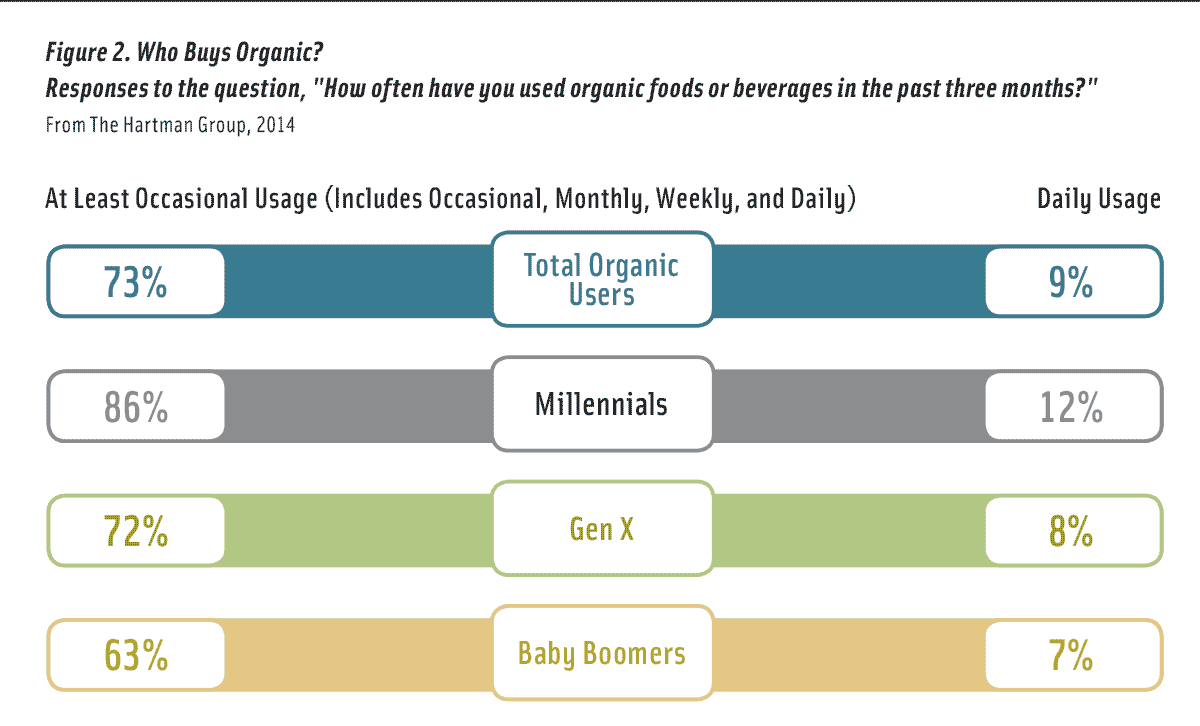 Mothers of young children, Hispanics, and Asian consumers are also strong drivers of organic food sales growth. Four in 10 moms with kids under age 2 buy organic; 25% of those with kids aged 12–17 do so (Packaged Facts 2012). Six in 10 Hispanics feel that organic foods are healthier than conventional foods/drinks, and 57% feel that way about natural foods (Packaged Facts 2014c).
Mothers of young children, Hispanics, and Asian consumers are also strong drivers of organic food sales growth. Four in 10 moms with kids under age 2 buy organic; 25% of those with kids aged 12–17 do so (Packaged Facts 2012). Six in 10 Hispanics feel that organic foods are healthier than conventional foods/drinks, and 57% feel that way about natural foods (Packaged Facts 2014c).
Adults under age 35 are contributing to explosive sales growth for natural/organic meats. The desire to avoid hormones, steroids, and antibiotics are their top purchase motivators (FMI 2015).
Millennials and Gen Xers are twice as likely as other age groups to shop at organic/natural stores. Whole Foods is creating a new store format positioned for Millennials (FMI 2014).
Moms aged 25–39 with kids under age 11, living in urban households, and with an income in the range of $50,000 to $99,000 are most concerned about GMOs. Concern over GMOs declines with age (Packaged Facts 2013b).
Older Millennials and Asian-American consumers are the most likely to buy foods labeled organic in order to avoid GMOs (Packaged Facts 2013b). Although eight in 10 adults occasionally buy local foods, young adults tend to define local as grown within a certain mile radius. Older shoppers associate local with closer to the farm (FMI 2014).
Seven in 10 Matures say that they are very interested in meat/poultry raised in the United States; 42% of Millennials share that perspective (FMI 2015). Younger adults are most concerned about how the animal was raised (e.g., cage-free, grass-fed, or humane treatment), fair wages (e.g., Fair Trade), and if foods are produced in an environmentally sustainable way (FMI 2015; IFIC 2015).
Those aged 18–34 are five times more likely than those aged 50-plus to be strict vegans or nonmeat/poultry/seafood consumers (MSI 2014c).
Panera Bread’s “No No List,” which includes acesulfame K, high fructose corn syrup, and maltodextrin, among other ingredients, should be of interest to clean label advocates. Panera’s salad dressings are formulated without artificial sweeteners, colors, flavors, or preservatives.
--- PAGE BREAK ---
Young at Heart
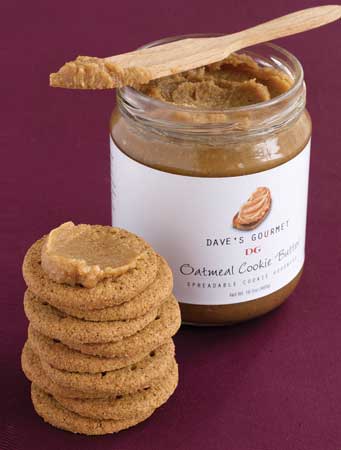 Accelerating interest in wellness and performance among younger generations as well as the unique demands of an aging population will accelerate and reorient the demand for better-for-you and functional foods.
Accelerating interest in wellness and performance among younger generations as well as the unique demands of an aging population will accelerate and reorient the demand for better-for-you and functional foods.
Over the past three years, the percentage of Millennials who say they are very concerned with the nutritional content of their food jumped 14%—from 23% in 2011 to 37% in 2014 (FMI 2014).
Boomers led the list of consumers trying to get more protein in 2014. Those under age 35 are most likely to believe that protein aids muscle recovery, promotes weight loss, builds muscle, and contributes to feelings of fullness (IFIC 2014).
Millennials are the most frequent users of protein shakes/bars as meal replacements; one-third of Millennials use such products from one to three times daily (Acosta 2014). Those aged 45–54 are the most likely to use high-protein beverages for energy (Mintel 2014d).
Two-thirds (69%) of Matures believe that protein helps maintain healthy bones/joints; 63% think that it prevents muscle loss during aging; 44% believe it prevents bone loss; and 39% think it helps boost immunity (DMI 2012).
Sixty-two percent of Boomers want to get more fiber; 57% seek more antioxidants, heart-healthy ingredients, and vitamins/minerals; 56% want more omega-3s and vitamin D; 54% seek more calcium; and 53% are interested in getting more whole grains (Nielsen 2014).
Millennials most want more calcium, vitamins/minerals, and fiber and plan to increase their protein intake (Nielsen 2014). Those aged 25–34 are the most likely to visit a restaurant because it offers some healthy menu items; they cite Subway, Panera Bread, and Chipotle Mexican Grill as the healthiest chain restaurants (Technomic 2014c).
 Young consumers are the most likely to experiment with specialized diets. In 2014 12% of Millennials tried a vegetarian food regimen; 10%, a gluten-free, lactose-free, or juice cleanse/detox approach; and 6%, a dairy-free or raw food diet (FMI 2014). The perspective on gluten-free may be shifting a bit, however. Forty-six percent of those aged 18–34 described gluten-free as healthy in 2014, down from 60% in 2012 (Technomic 2014d).
Young consumers are the most likely to experiment with specialized diets. In 2014 12% of Millennials tried a vegetarian food regimen; 10%, a gluten-free, lactose-free, or juice cleanse/detox approach; and 6%, a dairy-free or raw food diet (FMI 2014). The perspective on gluten-free may be shifting a bit, however. Forty-six percent of those aged 18–34 described gluten-free as healthy in 2014, down from 60% in 2012 (Technomic 2014d).
Millennials are the most likely to purchase nondairy milks (e.g., soy, almond); consumption falls with age. Trendy flavors are the top purchase drivers, not health (Mintel 2013d). Those aged 45–64 are the most likely to be trying to lose weight; those aged 65-plus are the most likely to be trying maintain their weight (Packaged Facts 2014d).
Baby Boomers were the most likely to think a lot about the amount of physical activity they get; 62% of Boomer women and 49% of Boomer men do so (IFIC 2014).
Those aged 35–49 are the largest cohort of sports nutrition food and drink users; this includes 54% of men in this age group and 46% of women (MSI 2012). Fifty-nine million women are exercise walkers, 29 million work out with equipment, and 27 million are aerobic exercisers (NSGA 2014). In addition, teen workouts are on the rise (HealthFocus 2012).
Young adults have begun linking specific health benefits with fresh foods. Seventy percent of Millennials associate meat with high protein, 62% link it with energy, and 53% relate it to building physical strength. More than half of seniors (57%) associate poultry with healthy weight; 46%, with heart health; and 25%, with brain health (FMI 2015).
Young adults are the most likely to use functional foods/beverages (64% versus 57% of consumers overall) (MSI 2014c). Those under age 35 are the most interested in foods for digestive support (Piu 2014). Young adults are also 75% more likely than other age groups to say their grocery shopping is influenced by an allergy, intolerance, or a dietary avoidance (Packaged Facts 2014e).
Maintaining the ability to continue with normal activities as they age, retaining mental sharpness, dealing with lack of energy, and concerns about cancer, bone health, and eyesight are the health issues those aged 50-plus are very concerned about. For those aged 18–34, the issues of concern include tiredness, lack of energy, stress, and bone health (HealthFocus 2013).
--- PAGE BREAK ---
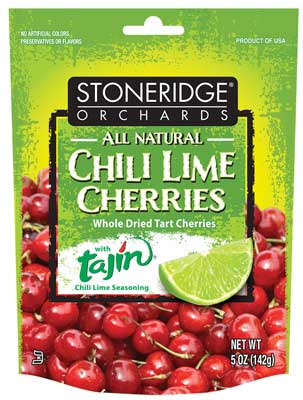 Latino Mania
Latino Mania
Hispanic food shoppers are projected to spend $86 billion on food by 2018, up from $63 billion in 2013 (Packaged Facts 2014c). Hispanics cook more on the stove top, buy more seasoned/further prepared meats, and are heavy users of retail prepared meals. Hispanics also cook more frequently than the general population (69% versus 61%) (IDDBA 2015; NPD 2013b).
Chicken tops the list of in-home dinner foods in Hispanic households, followed by vegetables/legumes, rice, and potatoes (NPD 2013b). Hispanics were the most likely to buy specialty foods in 2014 (SFA 2014). Sauces are on the least-used food list for Hispanics; 40% of Hispanics like to customize their spice profiles (Packaged Facts 2014c). While Hispanics are not as likely to snack as other groups, they’re more likely to snack with others (Hartman 2013a).
Spanish-dominant Hispanic households are nearly three times more likely to use baby food, cereal, and juice (Nielsen 2013). Hispanics are the group most likely to buy nutritional products for their children (Mintel 2013e).
In general, Hispanics are uniquely focused on energy and performance. Half (53%) are making an effort to eat a nutritious diet; 50% seek an energy boost/enhancement (MSI 2011b). Young Hispanic men represent an enormous untapped sports nutrition opportunity; 18% of men aged 18–24 and 12% of those aged 25–49 take a sport supplement (MSI 2011).
Hispanics are most often first to try a new health food, nutritional product, or diet (Packaged Facts 2014c). Four in 10 Hispanics (42%) are watching their diet for health; 53%, to lose or maintain weight; 31%, for cholesterol; 29%, blood sugar levels; 20%, high blood pressure; and 20%, diabetes (Mintel 2013e).
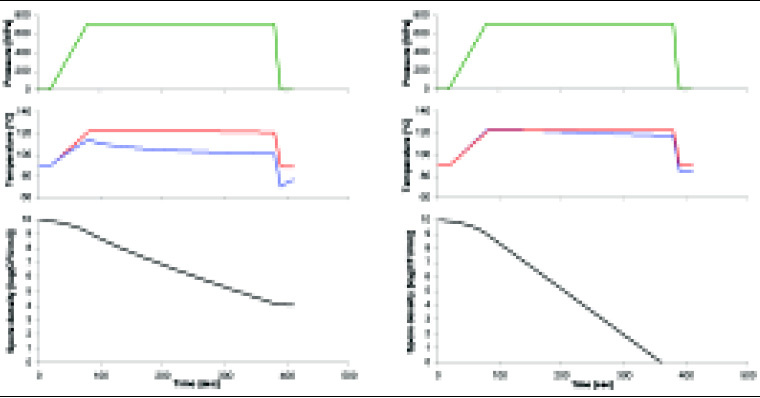 Hispanics’ per capita visits to restaurants increased by 4% in 2014 versus a 1% decline among non-Hispanics. Hispanic spending at restaurants also increased 4% last year versus a 3% increase among non-Hispanics (NPD 2015b).
Hispanics’ per capita visits to restaurants increased by 4% in 2014 versus a 1% decline among non-Hispanics. Hispanic spending at restaurants also increased 4% last year versus a 3% increase among non-Hispanics (NPD 2015b).
A. Elizabeth Sloan, PhD, a professional member of IFT and contributing editor of Food Technology, is president, Sloan Trends Inc., Escondido, Calif. ([email protected]).
References
Acosta. 2014. The Personalization of Protein Hot Topic Report. Oct. Acosta Sales & Marketing, Jacksonville, Fla. accosta.com.
DMI. 2012. Consumer Nutrition Survey. Dairy Management Inc., Rosemont, Ill. dairy.org.
FMI. 2014. U.S. Grocery Shopper Trends. Food Marketing Institute, Arlington, Va. fmi.org.
FMI. 2015. The Power of Meat.
Fry, R. 2015. “This Year, Millennials Will Overtake Baby Boomers.” Jan. 16. pewresearch.org.
Glazer, F. 2014. “Missing Millennials.” Nation’s Restaurant News 48(18): 80.
Glazer, F. 2015. “To Reach Millennials, Put Their Kids First.” Nation’s Restaurant News. 49(3): 52
Hartman. 2013a. Modern Eating: Cultural Roots, Daily Behaviors. The Hartman Group, Bellevue, Wash. hartman-group.com.
Hartman. 2013b. “Millennials in Focus: The Emerging Food Culture of the Young and Restless.” Presented at the Culinary Institute of America’s Worlds of Flavor Conference, Napa Valley, Calif., Nov. 14–16.
Hartman. 2014. The Organic Report.
Hartman. 2015. “Weekends Are Made for Marketers.” Hartman Group Newsletter, May 12.
HealthFocus. 2012. Teens From the Top Down. HealthFocus International, St. Petersburg, Fla. healthfocus.com.
HealthFocus. 2013. HealthFocus U.S. Trend Study.
HHS. 2015. Births: Final Data for 2013. National Vital Statistics Reports. (64): 1. Dept. of Health and Human Services.
IDDBA. 2014. Engaging the Evolving Shopper: Serving the New American Appetite. International Dairy-Deli-Bakery Assoc. Madison, Wis. iddba.org.
IDDBA. 2015. What’s in Store?
IFIC. 2014. 2014 Food & Health Survey. International Food Information Council Foundation, Washington, D.C. www.foodinsights.com.
IFIC. 2015. 2015 Food & Health Survey.
IRI. 2010. “Low Income Report.” New Product Pacesetters. Oct. Information Resources Inc., Chicago. iriworldwide.com.
IRI. 2014a. “Aging America: Carving Out Growth in Mature Markets,” Times & Trends, June.
IRI. 2014b. “New Product Pacesetters.” Times & Trends, April.
IRI. 2015. “Capture and Keep Your SNAP Shopper.” Presented at IRI 2015 Summit, April 20–22, Austin, Texas.
Mintel. 2013a. Cooking Enthusiasts. Mintel Group Ltd., Chicago, mintel.com.
Mintel. 2013b. Cooking Sauces, Marinades and Dressings—U.S. Dec.
Mintel. 2013c. Dry Pasta, Rice, Noodles and Ancient Grains—U.S. Feb.
Mintel. 2013d. Dairy and Non-Dairy Milk—U.S. April.
Mintel. 2013e. Hispanic Diet and Wellness—U.S. March.
Mintel. 2014a. Ethnic Foods—U.S. Jan.
Mintel. 2014b. Bread and Bread Products—U.S. Sept.
Mintel. 2014c. Dry Pasta, Rice, Noodles—U.S. Feb.
Mintel. 2014d. Nutritional and Performance Drinks—U.S. Jan.
MSI. 2011a. The 2011 Gallup Study of Dinner. Multi-sponsor Surveys, Princeton, N.J. multisponsor.com.
MSI. 2011b. The 2011 Gallup Study of Hispanic Nutrition & Supplement Use.
MSI. 2012. The 2012 Gallup Study of Sports Nutrition Products.
MSI. 2013. The 2013 Gallup Study of Clean Food & Beverage Labels.
MSI. 2014a. The 2014 Gallup Study of Cooking Knowledge & Skills.
MSI. 2014b. The 2014 Gallup Study of American Snacking Behavior.
MSI. 2014c. The 2014 Gallup Study of Nutrient Knowledge & Consumption.
Nielsen. 2013. Nielsen’s Hispanic Facts. The Nielsen Co., Schaumburg, Ill. nielsen.com.
Nielsen. 2014. Health & Wellness in America. Aug.
NPD. 2011. A Look into the Future of Eating. May. The NPD Group, Port Washington, N.Y. npd.com.
NPD. 2013a. “Boomers Increase Restaurant Visits While Millennials Cut Back.” Press release, Jan. 15.
NPD. 2013b. U.S. Hispanics: A Growing Opportunity.
NPD. 2014. The Future of Eating: Who’s Eating What in 2018.
NPD. 2015a. “Millennials Cut Restaurant Spending.” Nation’s Restaurant News 49(7): 80.
NPD. 2015b. “Data Snapshot: Impact of U.S. Hispanic Population Grows.” Nation’s Restaurant News. 49(6): 6.
NSGA. 2014. Statistics: Sports and Exercise 2013. National Sporting Goods Assoc., North Palm Beach, Fla. nsga.org.
Piu, L. 2014. “Marketing Digestive Products.” World of Nutrition, DSM, Dec.
Packaged Facts. 2012. Moms as Food Shoppers. Nov. Packaged Facts, Rockville, Md. packagedfacts.com.
Packaged Facts. 2013a. Baby Food and Babycare Supplies: U.S. Market Trends. Feb.
Packaged Facts. 2013b. Non-GMO Foods: U.S. Market Perspective. Oct.
Packaged Facts. 2014a. What America Eats. Nov.
Packaged Facts. 2014b. The Kids Food and Beverage Market in the U.S. Jan.
Packaged Facts. 2014c. Hispanic Food Shoppers in the U.S. June.
Packaged Facts. 2014d. Weight Management: U.S. Consumer Mindsets. Aug.
Packaged Facts. 2014e. Food Formulation Trends: Ingredients Consumers Avoid. Feb.
PMA. 2015. State of the Plate. Produce for Better Health Foundation. pbhfoundation.org.
SFA. 2014. Today’s Specialty Food Consumer. Specialty Food Assoc., New York, N.Y. specialtyfood.com.
SFA. 2015. The State of the Specialty Food Industry.
Technomic. 2013a. RMS Monitor: Product Trend Report. Technomic, Chicago. technomic.com
Technomic. 2013b. The Flavor Consumer Trend Report.
Technomic. 2014a. The Beverage Consumer Trend Report.
Technomic. 2014b. The Snacking Occasion Consumer Trend Report.
Technomic. 2014c. Healthy Eating Consumer Trend Report.
Technomic. 2014d. The Generational Consumer Trend Report.
U.S. Census. 2010. U.S. Census Bureau, Washington, D.C. census.gov.
